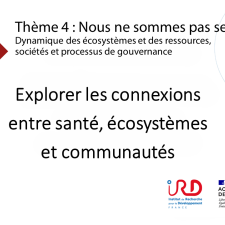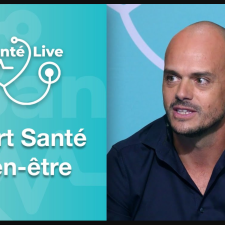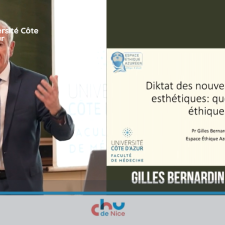Notice
Real world evidence for real life patients in a changing healthcare world
- document 1 document 2 document 3
- niveau 1 niveau 2 niveau 3
Descriptif
The randomizedclinical trial has long been the only source for gathering evidence about theeffectivity and safety of a new medicinal product to gain market access. In thechanging world of healthcare, where all new information about patients isflowing to the healthcare provider, the patient and Internet, patient orproduct-related information can now be integrated and used for obtaining proofof clinical effectiveness and patient benefit. New technologies for analysis,machine and automated learning are being integrated as well in the healthcareworld. Both structured and unstructured information and data coming fromscientific literature, patient social media, smart devices or electronic healthrecords, among others, are all relevant and knowledge about the patient outcomecan be extracted with advanced analysis methods. Automated learning techniques allow forbuilding decision-support machines that can determine whether a patient shouldbe dismissed from hospital, whether they are taking their drug on time when athome or if they should be contacted by their physician as their disease isworsening. This shift from productdelivery to patient outcomes in healthcare comes at a time when the analyticaltechnology, hardware and data standardization (e.g. OMOP, IDMP, CDISC) isallowing for massively parallel analysis of data. Understanding the patienthealth situation by analyzing their data fingerprint requires however anunderstanding of personalized medicine, respect for data privacy and anunderstanding of how the algorithms work. The gap between research and clinicalpractice remains wide but is narrowing – analytics, and the ability to make itusable by physicians, can further close that gap without breaking the systemeconomically or practically.
Sur le même thème
-
Explorer les connexions entre santé, écosystèmes et communautés.
Stéphanie SIGNORET présente la nouvelle définition du principe «One health » ( OHHLEEP, 2021), qui ajoute le rôle central des communautés. Elle montre comment intégrer cette dimension par l’approche
-
Santé Live #12 : Sport Santé Bien-Être
RACHOU Emmanuelle
HOAREAU Vincent
Santé Live #12 : Sport Santé Bien-Être
-
Observation de la santé à La Réunion : enjeux et évolution
RACHOU Emmanuelle
BRUNET-MALBRANCQ Joëlle
Causeries Santé - La santé publique #1 - Observation de la santé à La Réunion : enjeux et évolution
-
[jeu de maux] épisode 1. L'étymologie / la terminologie du suffixe -rrhée et la diarrhée
GUERRIAUD Mathieu
[Jeu de maux] épisode 1. L'étymologie / la terminologie du suffixe -rrhée et la diarrhée
-
[jeu de maux] épisode 4. L'étymologie / la terminologie des mots de la dermatologie (partie 1)
GUERRIAUD Mathieu
[jeu de maux] épisode 4. L'étymologie / la terminologie des mots de la dermatologie (partie 1)
-
[jeu de maux] épisode 2. L'étymologie / la terminologie des couleurs en santé (partie 1)
GUERRIAUD Mathieu
[Jeu de maux] épisode 2. L'étymologie / la terminologie des couleurs en santé (partie 1)
-
[jeu de maux] épisode 3. L'étymologie / la terminologie des Couleurs en santé (partie2)
GUERRIAUD Mathieu
[jeu de maux] épisode 3. L'étymologie / la terminologie des Couleurs en santé (partie2)
-
[jeu de maux] épisode 7. L'étymologie / la terminologie des mots de la douleur (partie 2)
GUERRIAUD Mathieu
[jeu de maux] épisode 7. L'étymologie / la terminologie des mots de la douleur (partie 2)
-
[jeu de maux] épisode 6. L'étymologie / la terminologie des mots de la douleur (partie 1)
GUERRIAUD Mathieu
[jeu de maux] épisode 6. L'étymologie / la terminologie des mots de la douleur (partie 1)
-
Diktat des nouveaux canons esthétiques: quels enjeux éthiques ?
BERNARDIN Gilles
Lors du 13e printemps éthique de Nice, le 15 mars 2024, le Pr Gilles Bernardin a présenté "Diktat des nouveaux canons esthétiques : quels enjeux éthiques ?". Cette conférence a examiné les pressions
-
Facing vulnerability in human research: reflections on ethical evaluation of (dis-)respect for and …
PEIčIUS Eimantas
La notion de vulnérabilité est souvent placée au cœur de la recherche sur l'éthique et les humanités en santé, mais il s’agit d’un élément théorique rarement approfondi. Elle est généralement
-
Les Causeries de l'Égalité - L'égalité et le genre #7 - Femmes et discriminations
DUCRET Marie Patricia
DECHEPY-TELLIER Johan
Les Causeries de l'Égalité - L'égalité et le genre #7 - Femmes et discriminations





![[Jeu de maux] épisode 1. L'étymologie / la terminologie du suffixe -rrhée et la diarrhée](https://vod.canal-u.tv/videos/2024/07/99220/jeu_de_maux-diarrhee.jpg)
![[jeu de maux] épisode 4. L'étymologie / la terminologie des mots de la dermatologie (partie 1)](https://vod.canal-u.tv/videos/2024/07/99225/jeux_de_maux-dermato_partie1.jpg)
![[Jeu de maux] épisode 2. L'étymologie / la terminologie des couleurs en santé (partie 1)](https://vod.canal-u.tv/videos/2024/07/99221/jeux_de_maux-couleur_partie1.jpg)
![[jeu de maux] épisode 3. L'étymologie / la terminologie des Couleurs en santé (partie2)](https://vod.canal-u.tv/videos/2024/07/99222/jeux_de_maux-couleur_partie2.jpg)
![[jeu de maux] épisode 7. L'étymologie / la terminologie des mots de la douleur (partie 2)](https://vod.canal-u.tv/videos/2024/07/99223/douleur_02.jpg)
![[jeu de maux] épisode 6. L'étymologie / la terminologie des mots de la douleur (partie 1)](https://vod.canal-u.tv/videos/2024/07/99219/douleur_01.jpg)


